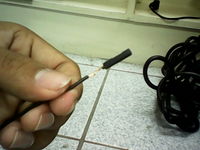UP-FM Transmitter: Difference between revisions
No edit summary |
|||
| Line 1: | Line 1: | ||
==PROCEEDURES== | ==PROCEEDURES== | ||
'''A. Making a Simple Antenna:''' | '''A. Making a Simple Antenna:''' | ||
*Since you don't have an ideal antenna,you will use a solid wire (no.22,) as a substitute antenna.Cut a solid wire about 32 cm(centimeters) and stripe one end at least 1 cm. Also cut the GPIO cable wire near the socket and leave at least 1 cm wire on it.Stripe the wire near the GPIO socket. Combine both ends of the solid wire and GPIO socket using lead and soldering iron.Wrap the soldered wire ang GPIO with the tape so that it will not stumble as shown below | *Since you don't have an ideal antenna,you will use a solid wire (no.22,) as a substitute antenna.Cut a solid wire about 32 cm(centimeters) and stripe one end at least 1 cm. Also cut the GPIO cable wire near the socket and leave at least 1 cm wire on it.Stripe the wire near the GPIO socket. Combine both ends of the solid wire and GPIO socket using lead and soldering iron.Wrap the soldered wire ang GPIO with the tape so that it will not stumble as shown below. | ||
[[File:IMG 20140423 130605.jpg|110px]] [[File:IMG 20140423 130743.jpg|200px]] [[File:IMG 20140423 130855.jpg|200px]] [[File:IMG 20140423 131006.jpg|200px]] | |||
[[File:IMG 20140423 131031.jpg|200px]] [[File:IMG 20140423 131101.jpg|200px]][[File:IMG 20140423 131151.jpg|200px]] [[File:IMG 20140423 131218.jpg|200px]][[File:IMG 20140423 131638.jpg|200px]] [[File:IMG 20140423 131724.jpg|200px]] [[File:IMG 20140423 132408.jpg|110px]] [[File:IMG 20140423 132752.jpg|110px]] | |||
'''B. Programming the PIfm:''' | '''B. Programming the PIfm:''' | ||
*You will now program the PIfm in Raspberry PI.First you must have an SD card with Raspbian "wheezy" OS. | |||
<br/> | <br/> | ||
Revision as of 14:46, 23 April 2014
PROCEEDURES
A. Making a Simple Antenna:
- Since you don't have an ideal antenna,you will use a solid wire (no.22,) as a substitute antenna.Cut a solid wire about 32 cm(centimeters) and stripe one end at least 1 cm. Also cut the GPIO cable wire near the socket and leave at least 1 cm wire on it.Stripe the wire near the GPIO socket. Combine both ends of the solid wire and GPIO socket using lead and soldering iron.Wrap the soldered wire ang GPIO with the tape so that it will not stumble as shown below.
B. Programming the PIfm:
- You will now program the PIfm in Raspberry PI.First you must have an SD card with Raspbian "wheezy" OS.














